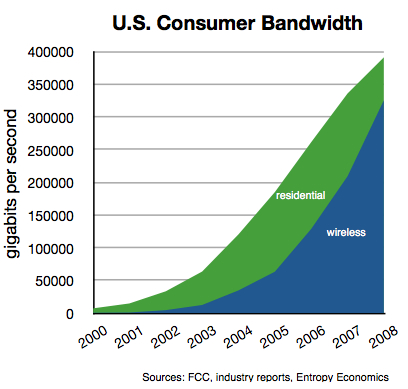After challenging Andy Kessler over the Google Voice-Apple-AT&T dustup, I should point out some areas of agreement.
Andy writes:
Some might say it is time to rethink our national communications policy. But even that’s obsolete. I’d start with a simple idea. There is no such thing as voice or text or music or TV shows or video. They are all just data.
Right, all these markets and business models in hardware, software, and content — core network, edge network, data center, storage, content delivery, operating system, browser, local software, software as a service (SAS), professional content, amateur content, advertising, subscriptions, etc. — are fusing via the Internet. Or at least they overlap in so many areas and at any moment are on the verge of converging in others, that any attempt to parse them into discreet sectors to be regulated is mostly futile. By the time you make up new categories, the categories change.
Which naturally applies to one of the most contentious topics in Net policy:
Competition brings de facto network neutrality and open access (if you don’t like one service blocking apps, use another), thus one less set of artificial rules to be gamed.
Exactly. Net Neutrality could be an unworkably complex and rigid intrusion into this highly dynamic space. Better to let companies compete and evolve.
Kessler concludes:
Data is toxic to old communications and media pipes. Instead, data gains value as it hops around in the packets that make up the Internet structure. New services like Twitter don’t need to file with the FCC.
And new features for apps like Google Voice are only limited by the imagination.
The Internet is disrupting communications companies. Although yesterday I defended the service providers, who are also the key investors in all-important Net infrastructure, it is true their legacy business models are under assault from the inexorable forces of quantum technologies. Web video assaults the cable companies’ discrete channel line-ups. Big bandwidth banished “long distance” voice and, as Kessler says, will continue disrupting voice calling plans. On the other hand, the robust latency and jitter requirements of voice and video, and the realities of cybersecurity will continue to modify the generalized principle that bits are bits.
Even if we can see where things are going — more openness, more modularity, more “bits are bits” — we can’t for the most part mandate these things by law. We have to let them happen. And in many cases, as with the Apple-AT&T iPhone, it was an integrated offering (the exclusive handset arrangement) that yielded an unprecedented unleashing of a new modular mobile phone arena. Those 100,000 new “apps” and a new, open Web-based mobile computing model. Integration and modularity are in constant tension and flux, building off one another, pulling and pushing on one another. Neither can claim ultimate virtue. We have to let them slug it out.
As I wrote yesterday, innovation yin and yang.


